The attraction of hummingbirds to the colour red has long fascinated nature enthusiasts and researchers alike. These enchanting birds, known for their remarkable agility and vibrant plumage, exhibit a strong affinity towards objects and flowers displaying shades of red.
Understanding why hummingbirds are so strongly attracted to this particular colour unveils fascinating insights into their evolutionary adaptations and foraging strategies.
The phenomenon can be explained through a combination of factors, including the birds’ specialized colour vision, the prevalence of red flowers producing nectar, the association between red and plentiful food sources, and the use of red as a territorial display.
By delving into these aspects, we can gain a deeper appreciation for the intricate relationship between hummingbirds and the colour red, shedding light on why are Hummingbirds attracted to red and the natural world’s captivating interconnections.
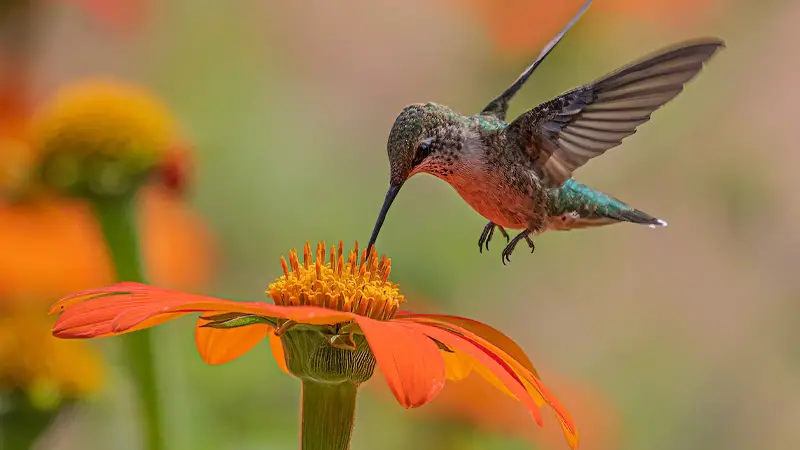
Why Are Hummingbirds Attracted To Red?
Hummingbirds are attracted to red for several reasons, which can be explained through a series of paragraph descriptions:
Colour Perception:
Hummingbirds have excellent colour vision, and they are particularly sensitive to the colour red. Their eyes contain specialized cones that are most receptive to red wavelengths.
This heightened sensitivity allows them to easily distinguish red hues from other colours in their environment, making red objects stand out and catch their attention.
Flower Adaptations:
Red is a common colour among flowers that hummingbirds feed on. Many flowers that rely on hummingbirds for pollination have evolved to feature vibrant red petals.
These flowers produce nectar, which serves as a rich source of energy for the birds. The bright red colour acts as a visual cue, signalling to hummingbirds that nectar is available, and they are naturally drawn to these red blossoms.
Nectar Abundance:
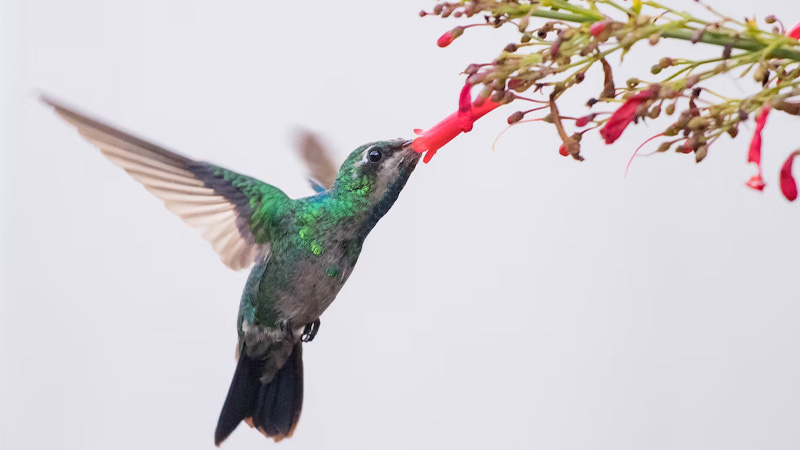
Hummingbirds have a high metabolic rate and need to consume large amounts of nectar to fuel their energy-intensive hovering flight. Red flowers often produce ample amounts of nectar, and the birds have learned to associate this colour with a bountiful supply of food.
Consequently, they are instinctively attracted to red as it signifies a potentially rewarding feeding opportunity.
Competition and Territory:
Hummingbirds are highly territorial and fiercely defend their feeding areas. The colour red not only attracts them to food sources but also serves as a signal of aggression and dominance.
Male hummingbirds, in particular, have vibrant red throat feathers called gorgets or “ruby throats,” which they prominently display during territorial disputes. This red display acts as a visual warning to rivals, indicating strength and readiness to defend their territory.
Camouflage and Predation:
Interestingly, while hummingbirds are attracted to red, this color may also help them camouflage against certain predators. Some natural predators of hummingbirds, such as hawks or larger birds, have limited ability to perceive red wavelengths.
Therefore, when a hummingbird perches on a red flower or tree branch, it may blend in with its surroundings, providing a measure of protection against potential threats.
The attraction of hummingbirds to red is a result of their excellent colour perception, the prevalence of red flowers producing nectar, the association between red and a plentiful food source, the use of red as a territorial display, and the potential camouflage benefits it provides against certain predators.
These factors combined make red a highly significant and alluring colour for hummingbirds.
Is There Any Color That Hummers Do Not Like?
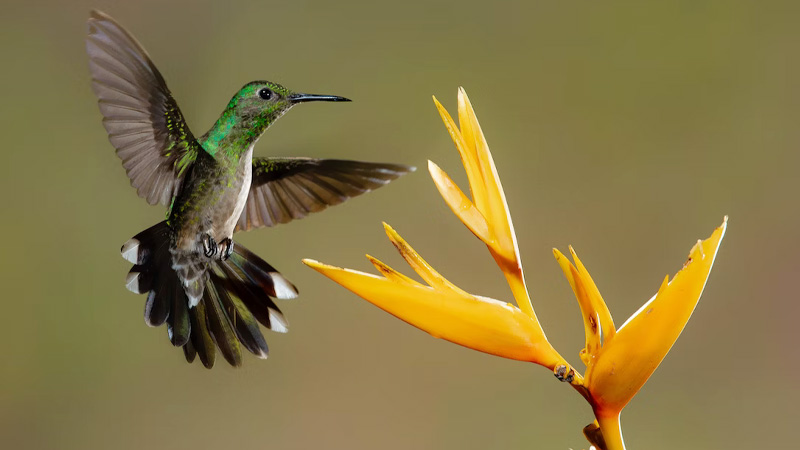
While hummingbirds are generally attracted to a variety of colours, there are certain colours that they may not be as inclined to visit.
Here are some colours that hummingbirds may not find as appealing, explained in paragraph descriptions:
Blue:
Hummingbirds are less attracted to blue-colored flowers. This is because blue is relatively rare in the natural environment and may not be as strongly associated with a food source.
While some hummingbird-pollinated flowers do feature blue hues, they are often accompanied by other colors, such as red or purple, to enhance their attractiveness to the birds.
Yellow:
Although yellow flowers can still attract hummingbirds, they may not be as effective as other colors. Yellow is a color that is commonly associated with bees and butterflies, and hummingbirds may have a preference for colors that are less frequently visited by these competitors.
While some species of hummingbirds do feed on yellow flowers, they are more likely to be attracted to colors like red, orange, and pink.
Green:
Green is a colour that hummingbirds see very well, as their vision is attuned to different shades of green. However, they may not be as drawn to pure green objects or flowers. Green is abundant in their natural surroundings, such as foliage and leaves, and may not stand out as much to hummingbirds in terms of signalling a food source or nectar availability.
Pale or Dull Colors:
Hummingbirds are generally attracted to bright and vibrant colours. Flowers with pale or dull colours, such as white or pastel shades, may be less appealing to them.
These colours may not provide the same visual impact and may not trigger the same instinctive response as more vibrant colours like red, orange, and pink.
Pure Black:
While hummingbirds can see black, pure black-coloured objects may not attract their attention as much.
Black is often associated with darkness or the absence of nectar, and it may not stimulate the same feeding response as colours that are more commonly associated with food sources.
It’s important to note that these colour preferences may vary among different species of hummingbirds, and individual preferences can also play a role.
Additionally, other factors such as flower shape, scent, and nectar quantity also influence hummingbird foraging choices.
Do Hummers Prefer Red Or Clear Nectar The Most?
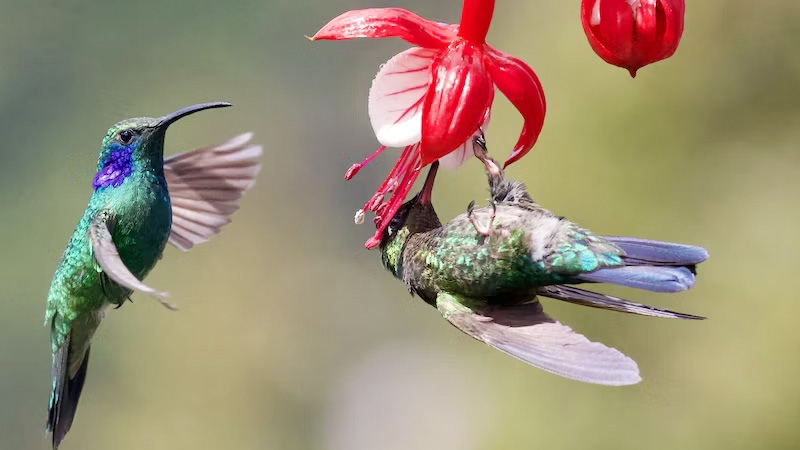
Hummingbirds have a strong preference for red nectar over clear nectar.
Here are some reasons why red nectar is more appealing to them, explained in paragraph descriptions:
Natural Association:
Red nectar closely mimics the colour of the flowers that hummingbirds typically feed on. Many hummingbird-pollinated flowers produce nectar that is naturally tinted red or contains pigments that give it a reddish hue.
As a result, hummingbirds have evolved to associate the colour red with a reliable food source.
Red nectar, whether naturally red or artificially coloured, triggers their instinctive feeding response more effectively than clear nectar.
Visual Cue:
Hummingbirds have excellent colour vision and are highly attracted to vibrant hues. Red nectar stands out visually, providing a strong visual cue that helps hummingbirds locate and identify a potential food source.
The bright colour contrasts with their natural surroundings, making it easier for them to spot and visit feeders or flowers containing red nectar.
Higher Energy Content:
Red nectar often contains a higher concentration of sugars compared to clear nectar. The increased sugar content provides a more energy-rich food source for hummingbirds.
Given their high metabolic rate and the energy demands of their hovering flight, hummingbirds are naturally inclined to seek out nectar with higher caloric content.
Red nectar, typically associated with more concentrated sugar solutions, offers a greater nutritional reward for their foraging efforts.
Competitive Advantage:
Hummingbirds are known for their territorial behaviour and competition for limited food resources.
The colour red plays a role in territorial displays and dominance among hummingbirds. By consuming red nectar, hummingbirds may benefit from the association of red with a bountiful food source and increased energy intake.
This may provide them with a competitive advantage over rivals, allowing them to maintain dominance over preferred feeding areas.
While hummingbirds do have a preference for red nectar, it’s important to note that they will still visit feeders or flowers containing clear nectar if other factors, such as flower shape, location, or nectar availability, are favourable.
Clear nectar can still serve as a viable food source, but red nectar has a stronger appeal due to its visual association, higher sugar content, and potential competitive advantage.
Is It Okay To Add Red Dye To Hummingbird Nectar?
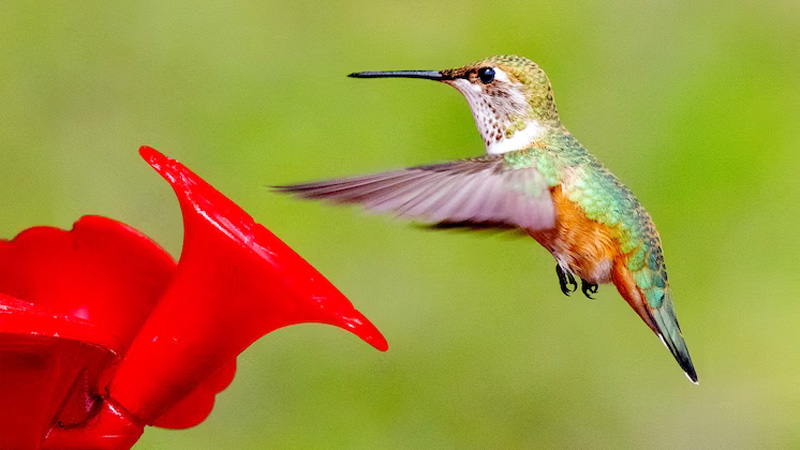
It is generally not recommended to add red dye or any artificial colourants to hummingbird nectar.
Here are some reasons why it’s best to avoid using red dye, explained in paragraph descriptions:
Health Concerns:
Red dyes or artificial colourants can potentially pose health risks to hummingbirds. Some red dyes contain additives or chemicals that may be harmful to these small birds.
While some dyes are considered safe for human consumption, hummingbirds have different metabolic processes and may react differently to these substances.
It’s important to prioritize the well-being and safety of hummingbirds by providing them with a natural and healthy diet.
Nutritional Disruption:
Adding red dye to nectar can alter its nutritional composition. Hummingbirds rely on the natural sugar content and energy-rich nectar provided by flowers.
Artificial additives can disrupt the balance of nutrients and potentially provide a less suitable food source.
The natural sugars found in floral nectar are sufficient to meet their dietary needs, and there is no evidence to suggest that adding red dye enhances their attraction or improves their health.
Attraction to Natural Colors:
Hummingbirds are naturally attracted to the colour red, as it is associated with their preferred food sources.
Using red-coloured feeders or providing nectar in red flowers is often sufficient to attract their attention and entice them to feed.
Artificial dyes are unnecessary and may even be less effective at attracting hummingbirds compared to natural red colors found in flowers or feeders.
Environmental Impact:
The use of red dye can have unintended consequences for the environment. When hummingbirds consume nectar with artificial dyes, they may excrete the colored waste, which can stain surfaces and vegetation.
Additionally, if spilt or leaked, the red dye can contaminate water sources and harm other wildlife or insects. It is crucial to maintain the ecological balance and minimize any negative impacts on the environment.
To ensure the health and well-being of hummingbirds, it is best to prepare nectar using a simple recipe of four parts water to one part white granulated sugar, without the use of any dyes or colourants.
Clean and refill feeders regularly to provide fresh and safe nectar for these delightful birds to enjoy.
FAQ
Hummingbirds are attracted to red because their specialized colour vision allows them to perceive red wavelengths more prominently. Their eyes contain specialized cones that are highly receptive to red, making red objects stand out and catch their attention.
While hummingbirds are attracted to a variety of colours, they do show a preference for red. Red is strongly associated with their preferred food sources, such as nectar-producing flowers.
Hummingbirds prefer red nectar because it closely mimics the natural colour of the flowers they feed on. Many hummingbird-pollinated flowers produce nectar that is naturally tinted red or contains pigments that give it a reddish hue.
It is generally not recommended to add artificial red color or dyes to hummingbird nectar. Natural red colors found in flowers or using red feeders are sufficient to attract hummingbirds.
While hummingbirds are generally attracted to a range of colors, there are certain colors that they may not be as inclined to visit. Blue, yellow, and pale or dull colors are examples of colors that may be less appealing to hummingbirds.
Conclusion
The attraction of hummingbirds to the colour red stems from a combination of innate and learned behaviours shaped by evolution.
The birds’ exceptional colour vision, heightened sensitivity to red wavelengths, and ability to discern red hues amidst their environment all contribute to their strong preference for red objects and flowers.
The abundance of red-coloured nectar-producing flowers serves as a natural incentive for hummingbirds, as they associate red with a bountiful food source rich in energy.
Additionally, the use of red in territorial displays highlights the significance of this colour in establishing dominance and defending vital resources.
While red undoubtedly holds a special allure for hummingbirds, it is important to note that factors such as flower shape, scent, and nectar availability also influence their foraging choices.
By unravelling the reasons behind their attraction to red, we gain a deeper understanding of these fascinating birds and the intricate dynamics that govern their interactions with the natural world.